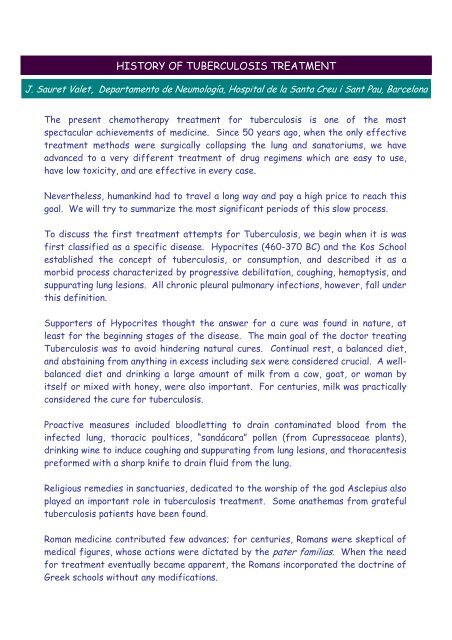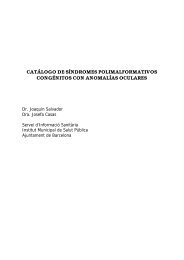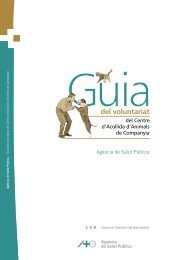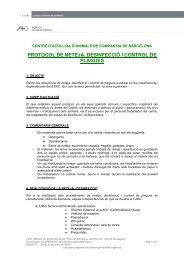HISTORY OF TUBERCULOSIS TREATMENT
HISTORY OF TUBERCULOSIS TREATMENT
HISTORY OF TUBERCULOSIS TREATMENT
Create successful ePaper yourself
Turn your PDF publications into a flip-book with our unique Google optimized e-Paper software.
<strong>HISTORY</strong> <strong>OF</strong> <strong>TUBERCULOSIS</strong> <strong>TREATMENT</strong><br />
J. Sauret Valet, Departamento de Neumología, Hospital de la Santa Creu i Sant Pau, Barcelona<br />
The present chemotherapy treatment for tuberculosis is one of the most<br />
spectacular achievements of medicine. Since 50 years ago, when the only effective<br />
treatment methods were surgically collapsing the lung and sanatoriums, we have<br />
advanced to a very different treatment of drug regimens which are easy to use,<br />
have low toxicity, and are effective in every case.<br />
Nevertheless, humankind had to travel a long way and pay a high price to reach this<br />
goal. We will try to summarize the most significant periods of this slow process.<br />
To discuss the first treatment attempts for Tuberculosis, we begin when it is was<br />
first classified as a specific disease. Hypocrites (460-370 BC) and the Kos School<br />
established the concept of tuberculosis, or consumption, and described it as a<br />
morbid process characterized by progressive debilitation, coughing, hemoptysis, and<br />
suppurating lung lesions. All chronic pleural pulmonary infections, however, fall under<br />
this definition.<br />
Supporters of Hypocrites thought the answer for a cure was found in nature, at<br />
least for the beginning stages of the disease. The main goal of the doctor treating<br />
Tuberculosis was to avoid hindering natural cures. Continual rest, a balanced diet,<br />
and abstaining from anything in excess including sex were considered crucial. A wellbalanced<br />
diet and drinking a large amount of milk from a cow, goat, or woman by<br />
itself or mixed with honey, were also important. For centuries, milk was practically<br />
considered the cure for tuberculosis.<br />
Proactive measures included bloodletting to drain contaminated blood from the<br />
infected lung, thoracic poultices, “sandácara” pollen (from Cupressaceae plants),<br />
drinking wine to induce coughing and suppurating from lung lesions, and thoracentesis<br />
preformed with a sharp knife to drain fluid from the lung.<br />
Religious remedies in sanctuaries, dedicated to the worship of the god Asclepius also<br />
played an important role in tuberculosis treatment. Some anathemas from grateful<br />
tuberculosis patients have been found.<br />
Roman medicine contributed few advances; for centuries, Romans were skeptical of<br />
medical figures, whose actions were dictated by the pater familias. When the need<br />
for treatment eventually became apparent, the Romans incorporated the doctrine of<br />
Greek schools without any modifications.
In the 2 nd century AC, Galileo suspected tuberculosis was contagious (also believed<br />
by Aristotle) and began to understand that resting the infected lung, like any other<br />
type of ulcer, was essential to healing. Similar to prior treatments, Galileo<br />
recommended placing the patient in a clean underground room and administering<br />
tisana (medicinal drink made with peeled barley) and a mix of plants with soothing<br />
properties for coughing. Traveling to the sea and to Egypt (for the dry climate)<br />
were considered beneficial to start the healing process.<br />
During the Middle Ages, after the invasion of the Eastern barbarians, the most<br />
important medical advances included founding of the first orphanage, hospital, and<br />
medical school and advances in treatment were scarce. The famous Flos Medicinae<br />
along with loosely translated aphorisms continued to place much importance on milk<br />
(from a goat was better than a donkey) mixed with salt and honey:<br />
Lac, sal miel i unge; bibat contra consumptus abunde.<br />
Lac nutrit, sal traducit, lac melli lisquecit.<br />
Lac si caprium, melius tamen est asinimum.<br />
An interesting therapy called “cure by regal touch” was started in the Middle Ages<br />
and persisted until the 19 th century. This privilege given to some kings (especially<br />
French and English) was to cure certain illnesses by placing their hands over the<br />
patient while reciting the phrase “the king touches you and God cures you.” The<br />
first news of healing came in the 11 th century, by Robert the Pious in France and<br />
Edwards the Confessor in England. Large crowds from every European country would<br />
come for the day chosen for the king’s healing. Scrofula was the preferred illness<br />
for “the touch.” It was not the only one; after some time, various monarchies<br />
became specialized. For example, the “specialty” of the Hungarian king was jaundice,<br />
the Spanish king specialized in insanity, Olaf of Norway in goiters, and the kings of<br />
England and France specialized in Scrofula and epilepsy.<br />
The Arabs, familiar with the texts of Hypocrites, Aristotle, and Galileo, assimilated<br />
with the classic beliefs: rest and a good diet were most important in tuberculosis<br />
treatment. In addition, infusion of rose petals could lead to extraordinary healing,<br />
according to Avicena.<br />
Revisionism during the Renaissance period impacted medicine and Galileo’s theories<br />
were abandoned as the indisputable truth little by little. The first anatomicpathological<br />
studies were started but advances in tuberculosis treatment were still<br />
scarce. Every type of plant with expectorant or soothing qualities was tested in<br />
various formulas and unconventional explanations. For example, Lungwort plants
were suggested as treatment by Paracelso because of their similar physical<br />
appearance to a healthy lung.<br />
Hygienic and dietary measures were still stringent, especially concerning sexual<br />
activities. A professor in Pauda, Juan Bautista Da Monte (1498-1552) skeptically<br />
vowed to find the cure to Tuberculosis for his young and beautiful wife. The most<br />
notable person of this period was Jerónimo Fracastro (1478-1553) from Verona and<br />
author of the theory in seminaria contagiosum. Fracastro suspected that<br />
tuberculosis and other diseases were contagious via seminaria, or bacteria, which<br />
penetrate a breathing organism and are absorbed and transported through the blood<br />
to the bowls.<br />
During the 16 th and 17 th centuries, sulfur, arsenic, mercury, and every type of plant<br />
from the New World such as quinine (tea), cocoa, and tobacco were all thoroughly<br />
tested and none were found to be useful.<br />
The concept that Tuberculosis was contagious was believed in countries on the<br />
Mediterranean coast (Spain and Italy). In the 18 th century, some cities adapted<br />
advanced prophylactic laws which included obligatory notification of cases, isolation<br />
of patients, alienation, and burning the personal belongings of deceased patients.<br />
These laws were made into official ordinances in 1751 by Fernando XI for all of his<br />
kingdom. Shortly after, they were also enforced with a few modifications by the<br />
duke of Tuscany and by the king of Naples. Unfortunately, the Napoleon conquerors<br />
tried to denounce the ordinances since there were few others in Europe who<br />
believed that tuberculosis was a contagious disease.<br />
This treatment was implemented with few major changes well into the 19 th century.<br />
In 1865, Villemin inoculated tuberculosis and in 1880-1882 R. Koch isolated and<br />
cultivated the bacteria responsible for tuberculosis. Tuberculosis could then be<br />
categorized as an infectious-contagious disease, the basis for an anti-tuberculosis<br />
solution.<br />
Nevertheless, various medications such as arsenic, tannin, iodine, tar inhalants,<br />
creosote, and alcohol continued to be used ineffectively. Leudet curiously theorized<br />
in 1864 that “tuberculosis is less frequent in professional drinkers that in abstinent<br />
subjects.”<br />
Doctors recommended trips to exotic locations (for wealthy patients) in search of an<br />
impossible cure. For example, trips to Rome or Venice were popular at one time<br />
under the presumption that malaria emanations of the cities were beneficial; malaria<br />
was already considered an antagonist disease to tuberculosis.
In 1860, Hermann Brehmer from Germany started the first center in Göbersdorf to<br />
cure tuberculosis by rest. He believed that the mountain fresh air and over-feeding<br />
in an establishment more like a luxury hotel than a hospital would strengthen the<br />
patient. His student, Peter Dettweiter, founded a famous center in Falkenstein in<br />
1876 and was the first to use the name sanatorium for his establishments.<br />
Treatment in sanatoriums quickly spread throughout Europe and America mainly<br />
because of modifications that made them accessible to patients of any class. Until<br />
the advent of chemotherapy, sanatoriums were the best alternative to treatment,<br />
especially in the beginning stages of the disease.<br />
Studies by Toussaint demonstrated changes in tuberculosis lesions when spontaneous<br />
pneumothorax is produced. In 1888, an Italian, Carlo Forlanini preformed the first<br />
intentional spontaneous pneumothorax using a needle to puncture the pleual cavity<br />
and then administering nitrogen. At the same time a North American surgeon, J.B.<br />
Murphy, preformed a similar experiment using a thick trocar to make an incision in<br />
the thoracic cavity.<br />
Collapsing the lung quickly became important because the surgical procedure was<br />
more explicit than any others previously explained. Collapsing lungs using more<br />
technical surgery was started shortly after. In 1907, Friedrich preformed the first<br />
thoracoplasty with extensive alveolar resectioning at the expense of serious<br />
alterations to the thoracic cavity and high mortality. In the following years, the<br />
procedure was slowly perfected and preformed with less harm. Toward 1930,<br />
pulmonary tuberculosis had been converted to a surgical disease and these new<br />
techniques form the basis of modern thoracic surgery today.<br />
In 1920, a microbiologist, A. Calmette, and his veterinarian student, C. Guerin, spent<br />
three years cultivating bacteria and eventually found a bovine species of bacteria<br />
with rare virulence that could possibly be developed into active immunity against<br />
tuberculosis. The BCG vaccine was a great hope to many but because of its<br />
widespread use, actually became an obstacle for the powerful impact of modern<br />
chemotherapy. In fact, the observations by A. Fleming in 1929 about the<br />
antibacterial properties of molds initiated spectacular changes in the treatment of<br />
infectious-contagious diseases.<br />
A few years after the discovery of penicillin, Selman A. Waksman demonstrated that<br />
small fungi of the genus Streptomyces griseus inhibit the growth of m.tuberculosis<br />
cultures because of a substance called streptomycin. The massive industrial<br />
production of streptomycin in 1946 produced the first effective chemotherapy
against tuberculosis. It was then discovered that streptomycin was not the<br />
miraculous drug that was hoped for; a few months after apparent healing, the<br />
patients’ lesions were reopened because the bacteria had developed mutant strains<br />
resistant to antibiotic action.<br />
J. Lehman isolated para-amino-salicylic acid in 1944 and later discovered isonaizid, a<br />
hydrazine from isonicotinic acid. Administration of isonaizid with streptomycin<br />
solved the problem of resistance and finally achieved the long-lived dream of<br />
mankind: to find a chemotherapy treatment to cure all the cases and visceral regions<br />
of tuberculosis. Despite its advantages, a serious inconvenience to the<br />
effectiveness of the treatment was the need to administer the drugs for 12-18<br />
months to ensure sterilization.<br />
In 1966, the Italian Pietro Sensi isolated rifamycin S from fungus of the genus<br />
Streptomyces mediterranii. It was supposedly a new treatment revolution to be<br />
verified upon experimental studies because its actions against all types of bacteria<br />
complimented the specific activity of pyrazinamide against intercellular bacteria.<br />
These findings were the basis of shortened chemotherapy treatment of 6 months.<br />
They were tested in a clinical study in east Africa between 1972 and 1976 and were<br />
recommended as initial treatment for tuberculosis.<br />
AIDS and the recent increase of resistance and multi-resistance to rifampicin and<br />
isonaizid in some third-world countries and poor districts of large urban regions has<br />
had a negative impact on chemotherapy tuberculosis treatment. We cannot let our<br />
guard down and we need economic support for the research of new drugs and<br />
synthetic vaccines to confront the challenge of tuberculosis in the 21 st century.










